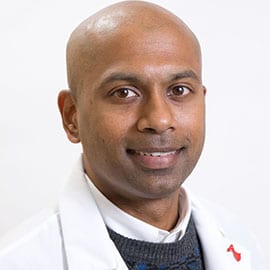
Tachycardia is when someone’s heart rate exceeds 100 beats per minute and can be caused by multiple types of irregular heart rhythms. A normal resting heart rate is around 60 to 100 beats per minute. It can be dangerous if the heart rate beats faster because the heart has less time to fill with blood and pump it to your cells.
A fast heart rate is not always concerning. Your heart naturally rises during instances such as exercise, stress or anxiety. This type of tachycardia is called sinus tachycardia.
There are many other types of tachycardia that are caused by irregular heart rhythms:
- Atrial fibrillation: This arrhythmia is more common with aging. A fast heart rate is caused by irregular and chaotic electrical signals in the atria (the heart’s upper chambers).
- Atrial flutter: Atrial flutter is similar to atrial fibrillation; however, the heartbeats are more regular versus uniform.
- Supraventricular: Supraventricular tachycardia is a rhythmic heartbeat that is rapid and starts above the ventricles. It can begin suddenly, lasts for a variable duration and may require medical intervention to correct.
- Ventricular: Ventricular tachycardia starts in the lower chambers of the heart, also known as the ventricles. The ventricles may not be able to pump enough blood throughout the body due to a rapid heart rate. This arrhythmia may be life-threatening.
- Ventricular fibrillation: This arrhythmia is life-threatening and leads to death if not corrected immediately.
Tachycardia can have many types of symptoms. Some symptoms of tachycardia are:
- Heart palpitations or the feeling of a pounding heart
- Light-headedness or dizziness
- Fast pulse
- Fainting
- Chest pain
- Shortness of breath
If you experience these symptoms, we recommend consulting your doctor or a specialist. In rare cases, immediate medical help is needed. Some types of tachycardia can cause blood pressure to drop dangerously low.
If you’re struggling with irregular heart rhythms or tachycardia, UofL Health’s team of heart care providers may be able to help. Visit UofLHealth.org to learn more or schedule your appointment today.








